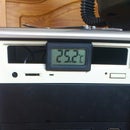Introduction: LED Strip Bias Lighting
Bias lighting is diffuse light around a monitor or TV. Bias lighting reduces eyestrain when working at night, increases the apparent contrast of the screen and it also looks impressive. In this instructable I'll show you how to add great looking bias lighting to your screen for just a few euros.
For more about bias lighting: http://www.howtogeek.com/213464/how-to-decrease-eye-fatigue-while-watching-tv-and-gaming-with-bias-lighting/
Step 1: What You Need
Materials
- Warm white LED strip (or any colour you prefer). For the warm whites you can choose from the following LEDs from dim to bright: 3528, 5050, 5630. I ordered 5630 LEDs and they are a bit too bright for this purpose. Make sure to search for some demos of the LEDs you want to order. €1.50 per meter
- Speaker wire. Two parallel wires, to connect the LED strip to a power source. €1 per meter
- Power source. In this instructable I use my PC's PSU for powering the LEDs, as it's a good 12V power source, and it will switch off the LEDs when I'm not using the computer. You can also use a 12V DC adapter, order a DC jack plug too in that case. €0
- Power connector: breadboard wires/Molex connector/DC jack €0.20
Tools needed
- Soldering iron
- Wire stripper or knife
Step 2: Attaching the LEDs to the Monitor
First, cut the LED strip to the desired length. Make sure you cut at one of the cut marks with contacts on them.
Next, solder one end of your speaker wire to the LED strip, and make sure you know which colour corresponds with positive and negative.
If your monitor is dusty, clean it first to ensure good attachment of the adhesive strip. Then, once you've made sure one more time that the strip is of the correct length, take of the adhesive strip protection on the back of the LEDs off and carefully put the LEDs on your monitor.
Unless you're really confident in your soldering skills, I would recommend to tape the wire near the contact to reduce strain on the soldered contact. I also led the wire behind the stand for the sake of cable management.
Adding an on/off switch to the wire can be useful, since you won't need the light to be on when there's enough daylight present.
Step 3: Connecting Your PSU With the LED Strip
Depending on what connectors you have left on your PSU, create a connector for the LED strip to the PSU. I used the floppy connector, which is the easiest, since you can just use breadboard wires for it. Make sure you connect the correct polarities and voltage line (12V - yellow).
Get creative with leading the wire into the case.
Step 4: Done
Awe at the result of your work.
If you're a bit of a perfectionist, here are some potential improvements:
- On/off switch for the strip
- Light diffusing cover
- All around bias lighting
And for the really ambitious ones: RGD LED strip that matches the screen content (Ambilight).













